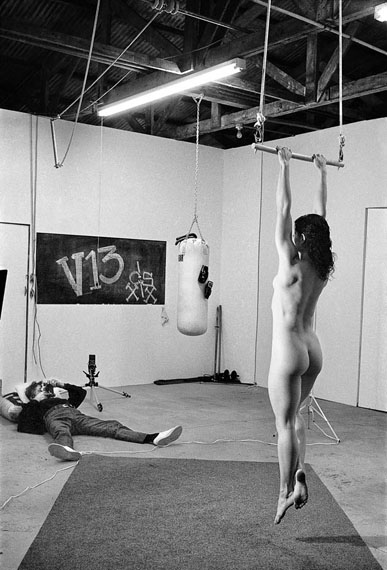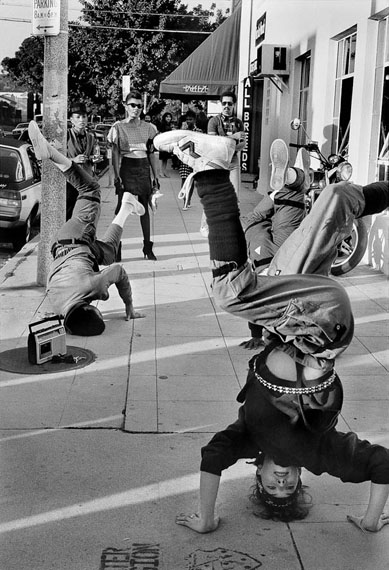
Helmut Newton with Lisa Lyon, Venice, California 1981
© Alice Springs
Alice Springs (June Newton) »
The MEP Show
Exhibition: 2 Jun 2016 – 14 May 2017
Wed 1 Jun 20:00

Helmut Newton Foundation
Jebensstr. 2
10623 Berlin
+49 (0)30-31864856
info@helmut-newton-foundation.org
www.helmutnewton.com
Tue-Sun 11-19, Thu 11-20

Malibu, 1983
© Alice Springs
Alice Springs: The MEP Show
Helmut Newton: Yellow Press
Mart Engelen: Portraits
Exhibition: 2 June, 2016 – 14 May, 2017
Opening: Wednesday, 1 June, 8 p.m.
In cooperation with the EMOP Berlin - European Month of Photography 2016
The title of the upcoming exhibition, Alice Springs: The MEP Show / Helmut Newton: Yellow Press / Mart Engelen: Portraits, unites not only three photographers, but also three different photographic approaches.
Since 1970, June Newton, widow of the legendary photographer of fashion and nudes, has also worked as a photographer, under the pseudonym Alice Springs. She and Helmut Newton have frequently exhibited their works together, especially their joint project "Us and Them". In 2010, the first Alice Springs retrospective was hosted at the Helmut Newton Foundation; now, her second retrospective, organized in 2015 by the Maison Européenne de la Photographie (MEP) in Paris, will also be shown in Berlin and accompanied by a book published by TASCHEN. In more than 100 portraits of her fellow photographers – including Richard Avedon, Brassaï, Ralph Gibson, and of course Helmut Newton – as well as other celebrities such as Nicole Kidman, Audrey Hepburn, Christopher Lambert, and Claude Chabrol, Alice Springs succeeds in capturing not only the look of the represented, but also their aura. The wordless dialogue that leads to such extraordinary portraits seems to stem from a kind of spiritual kinship. Intense portraits in both black & white and color are complemented by an expansive series of street photographs shot along Melrose Avenue in Los Angeles, where Alice Springs attentively documented California’s developing punk and hip-hop scenes in the 1980s. Anarchic youth culture, at times characterized by radical hairstyles and shrill body piercings, rejected the notion of capitalist society. Only a few years later, this musically and fashion-based protest movement in California subsided. What remained of it is the artistic inventory now on exhibit, where the punks posed and the photographer directed. The images exude a sense of empathy for their human subjects, and it is the noticeable mixture of rapport and curiosity that continues to make the work of Alice Springs interesting today.
�
Alice Springs: The MEP Show
Helmut Newton: Yellow Press
Mart Engelen: Portraits
Ausstellung: 2. Juni bis 14. Mai 2017
Eröffnung: Mittwoch, 1. Juni, 20 Uhr
Im Rahmen des EMOP Berlin - European Month of Photography 2016
Unter dem Titel "Alice Springs: The MEP Show / Helmut Newton: Yellow Press / Mart Engelen: Portraits" vereint die Ausstellung nicht nur drei Bildautoren, sondern auch drei unterschiedliche fotografische Ansätze.
Seit 1970 arbeitete June Newton, Witwe des legendären Mode- und Aktfotografen, unter dem Pseudonym Alice Springs selbst als Fotografin. Mehrfach haben sie und Helmut Newton zusammen ausgestellt, insbesondere das gemeinsame Projekt "Us and Them". 2010 wurde die erste Alice Springs-Retrospektive in der Helmut Newton Stiftung realisiert; nun wird die 2015 vom Pariser Maison Européenne de la Photographie (MEP) organisierte zweite Retrospektive ebenfalls in Berlin gezeigt und von einer Publikation im Taschen-Verlag begleitet. In den zahlreichen Porträts ihrer Fotografenkollegen – darunter Richard Avedon, Brassaï, Ralph Gibson und natürlich Helmut Newton – sowie anderer Prominenter wie Nicole Kidman, Audrey Hepburn, Christopher Lambert oder Claude Chabrol gelingt es Alice Springs nicht nur, das Aussehen der Dargestellten einzufangen, sondern auch deren Aura. Der wortlose Dialog, der zu den außergewöhnlichen Porträts führt, scheint auf einer Art Seelenverwandtschaft zu fußen.
Die intensiven Bildnisse in Schwarz-Weiß und Farbe werden durch eine umfangreiche Bildserie von Straßenfotografien ergänzt, die in der Melrose Avenue in Los Angeles entstanden, wo Alice Springs in den 1980er-Jahren die kalifornische Punk- und HipHop-Szene aufmerksam dokumentierte. Diese anarchische Jugendkultur, gekennzeichnet durch teilweise radikale Frisuren und schrille Piercings, verweigerte sich der Idee einer kapitalistischen Gesellschaft. Nur einige Jahre später verebbte die musikalisch und modisch fundierte Protestbewegung in Kalifornien wieder; was von ihr blieb, ist die ausgestellte künstlerische Bestandsaufnahme, bei der die Punks posierten und die Fotografin inszenierte. Stets sind es Menschenbilder voller Empathie, die spürbare Mischung aus Einfühlung und Neugierde macht das Werk von Alice Springs bis heute so interessant.�